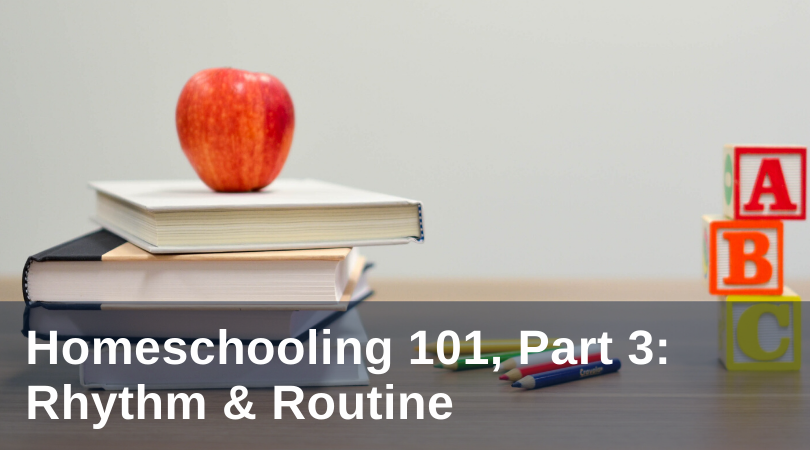
In the first part of this series, I offered some foundational thoughts on homeschooling and crisis management during quarantine. Part two covered meeting everyone’s essential needs. With basics covered, a daily routine comes into play.
I like the idea of a routine or rhythm as opposed to schedule; it’s a reminder that the “order of the day” is a tool to serve us, not something that we serve. As Jennifer Fulwiler encourages, take things easy, be gentle, create a flow. For my children, I reserve schooltime for after breakfast and lunch, when everyone’s satiated and fresh. We take mini-breaks between lessons if the kids are burnt out. Learning is the goal, not forcing productivity.
I’ve been a Montessori fan for a long time. Distilled, it’s a way of relating to the child with dignity by “teaching them to fish,” and guiding their hunger to experience the created world as it is. Kids are capable of much more than we give them credit for! By respecting and nurturing their capabilities, everyone thrives, making life easier for the parent after the initial investment of arranging the environment and introducing kids to different “works,” or activities. Here’s a sampling of works for 3–6 year olds; older children may enjoy some of them too. The child learns best with the freedom to choose their work; sometimes he or she will last five minutes, other days an hour, and again, that’s fine—the point is for their engagement to be self-directed and immersive.
Build, curate, and stock a home environment that allows safe and confident self-direction. Minimize clutter—it’s cathartic to go full Marie Kondo and cultivate beautiful simplicity! Rotate toys—kids will experience novelty without your having to buy new stuff, and they’ll play more freely without being overwhelmed. Live plants here and there are calming, and little ones like to help take care of them. Remember: kids love beauty just like adults; it relaxes everyone and encourages extended immersive play, so you can get more done.
Try to choose toys that encourage hours of that aforementioned self-directed engagement. Playmobil is my kids’ favorite; these little lifelike figures bridge different age groups and interests. My three have spent entire days creating Playmobil families, zoos, villages, shops, you name it. I don’t consider this a ‘waste’ of a day; it’s formation! They’re learning to collaborate, creatively accommodate different interests, and empathize. They work things out through the characters in their world, from fake fights and resolutions to block-tower cathedrals for Playmobil Masses and Confessions (you should hear the sins they come up with!). Some kids love Legos; others prefer Magnatiles. Whatever encourages long stretches of highly creative work, go for it!
As part of our routine, I set up the home environment to allow the kids to prepare their own snacks and drinks (they can begin to do this around age three with some help). It’s a fantastic way to build independence. I keep a child-sized glass pitcher and cups on a low table in the dining room so they can get water whenever they’re thirsty. The lowest cabinet of the pantry and the pull-out fridge drawer (both reachable for my five-year-old) are stocked with nourishing snacks: nuts, hummus, cheese, applesauce pouches, crackers, sliced fruit and carrots. Again, teach them to “fish,” so they can confidently move through their day and build skills, while you can, in large part, stay in your zone when you need to work. Meal prep and baking are key opportunities to connect; ask their help with whatever tasks they’re able. Younger kids delight in being entrusted with responsibility, and older kids like to chat while working.
I’ve learned to be judicious with screen-time. Within the right parameters it can genuinely be a help! However, I opt for the ‘electronic babysitter’ only under certain conditions, because I know that whatever time I buy on the front end, I will pay for later. At best, my kids are more squirrely and needy after whatever they watch; at worst, it precipitates full-blown meltdowns. Right now, I reserve their screen time for my Zoom meetings; I try to make it an exciting, scheduled event that they can look forward to rather than an activity we default to on the fly. I set up a special area where they can watch comfortably and put out snacks over a picnic blanket so my calls go smoothly. On the back end, I block out time to read to them or have a meal ready to mitigate the fallout. Interestingly, Mr. Rogers’ Neighborhood is the only show they can watch without becoming to some degree overstimulated. Designed with developmental theory in mind, it’s slowly paced and deliberately “conversational,” and is well worth trying for young children (and even older ones!).
After tending to the basics and establishing a routine, you can explore other resources for more ideas—I’ll share a list of the ones I’ve found most helpful in the last installment of this series.
Like what you read? Submit your email below to have our newest blogs delivered directly to your inbox each week.


